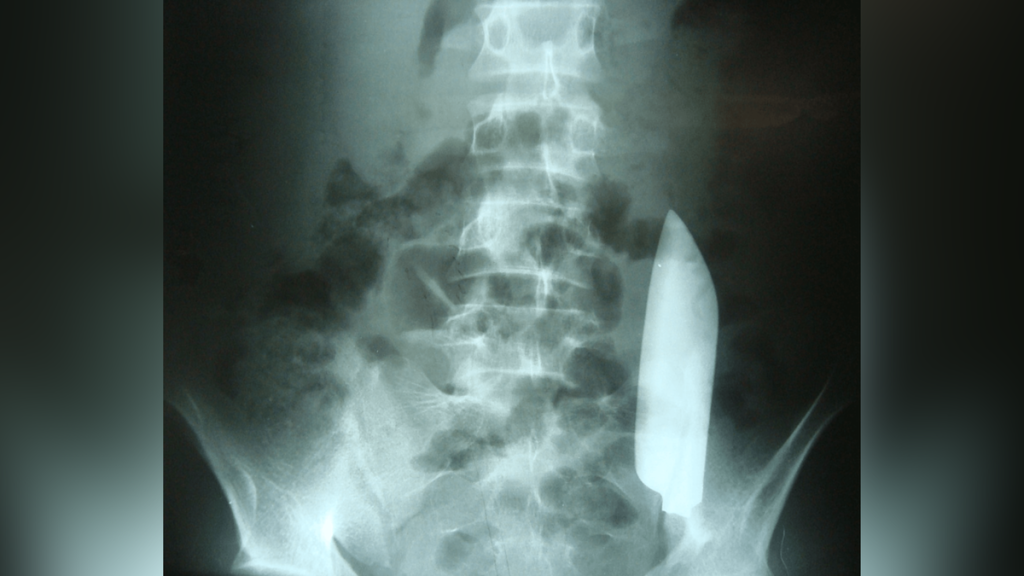An X-ray revealed that the blade had moved from the right to the left side of a man’s belly after he was stabbed. (Image credit: Nepal, A, Rajbhandari A P., et al. (2023). doi:10.7759/cureus.44575 (https://creativecommons.org/licenses/by/4.0/))
A man got stitched up after being stabbed with a knife — but the next day, he learned that the nearly half-foot blade was still in his belly.
The man in Nepal had been stabbed in the upper-right abdomen during a fight, which he poorly remembered due to being drunk. After the stabbing, the 22-year-old was taken to a “local medical shop,” where a health care worker apparently closed up his wound without checking if any part of it was still stuck in his belly and sent him on his way, according to a case report published Sept. 2 in the journal Cureus.
A day later, the man went to the emergency department because he had mild, continuous pain in his lower-left belly. At first glance, the man didn’t have any swelling or symptoms that suggested gastrointestinal issues, like nausea, diarrhea or constipation, although he did have a sutured wound on his right side and tenderness above his left hip. Nor did he have signs of peritonitis, a condition in which the inner lining of the abdominal cavity becomes inflamed, which can happen after the tissue is injured in a stabbing.
The doctors took an X-ray of the man’s abdomen and found something “unusual and spectacular”: The 5.9-inch (15 centimeters) blade from the attack was still floating in his belly and had “wandered” from one side to the other, yet none of the surrounding organs were severely injured, his doctors reported.
Related: Teen had a shard of glass stuck in his face for a month without knowing it
There was, however, a small, 0.4-inch-long (1 cm) cut on the front of his liver. Given that the liver is located in the upper-right abdomen, this injury was likely from the initial attack, the authors wrote.
Stab injuries to the belly are common, but it is rare to see an object like a blade retained inside the body afterward, the authors noted. In particular, cases of knife blades remaining in the body are few and far between and have been more likely to be than in the belly.
The knife blade after it was surgically removed, pictured alongside a (10 milliliter) syringe. (Image credit: Nepal, A, Rajbhandari A P., et al. (2023). doi:10.7759/cureus.44575 (https://creativecommons.org/licenses/by/4.0/))
However, there have been reports of people eating sharp objects — such as clasp knives, blades and needles — that then somehow migrated through their bodies.
Upon discovering the blade in the man in the new report, his doctors surgically removed the weapon. The patient made a full recovery and was released from the hospital five days later.
It’s unclear why the blade wasn’t spotted by the man’s initial health care provider, although the authors wrote that it may have been because “nobody suspected there could be any retained foreign body inside the abdominal cavity.” They added that the most “wondrous part” of this case — the way the blade floated through the belly without damaging any organs — also remains a mystery.

